More than 1.5 billion people are learning English worldwide.
80% of European citizens aged 15-30 years old know at least one foreign language.
They learn languages for travel, business, and self-improvement. Surprisingly, many people do not even need a specific reason. 46% of Babbel users said that they study a foreign language just because they enjoy it, and 35% of respondents learn languages to keep their brains fit.
Let's find the answers to the questions: How to create a language learning app? How to overcome the most common challenges? And how does Duolingo make money with only 2% of paid accounts?
State of the global language learning market
Online language learning apps have transformed language education, making it instantly accessible, affordable, and flexible. These platforms cater to a diverse array of linguistic interests, from popular languages like English, French, Spanish, and Chinese to lesser-known tongues such as Gaelic, Welsh, Navajo, and Esperanto. Learners can engage in various formats, from live Zoom lessons and social media courses to interactions with native speakers through apps and structured courses on specialized platforms.
The adaptability of these eLearning tools became particularly evident during the COVID-19 pandemic, which significantly influenced the market. The increased time at home not only allowed individuals to enhance their language skills but also led to a surge in app usage as people sought meaningful activities amidst lockdowns. Despite economic challenges that curtailed discretionary spending, many language platforms attracted new users by offering free access, converting them into regular learners post-pandemic.
The resilience of the online language learning market continues to grow, driven by seasonal trends and significant global events. For instance, there was a spike in downloads in August 2024, with over 26.5 million installs, primarily during the back-to-school period. The market also saw a noticeable increase at the start of the year as people set new learning goals. Financially, the sector has been thriving. In 2023, Duolingo led the pack by generating over $531 million, contributing to the industry's $1.08 billion revenue—a 28% increase from the previous year.
This growth is supported by technological advancements. For example, Duolingo has integrated OpenAI's GPT-4 for course creation and Babbel has enhanced its offerings with AI-driven speech recognition, which ensures that the learning experience is not only more effective but also engaging, and keeps these platforms competitive in the rapidly evolving educational technology landscape.
.png)
Top languages learning apps
To create your own language app, it is important to know who your competitors are, how they monetize their business, and what success they have achieved.
Language learning platform types
Currently, language websites can be divided into the following types:
- Language courses: Duolingo, Babbel, Rosetta Stone
- Flashcards and Spaced Repetition Systems: Memrise, Quizlet, Brainscrape
- Educational games: Mindsnaks, Tinycards, Anki App
- Contextual reference: Leaf
- Social media: Tandem, iTalki, HiNative, HelloTalk
Let’s look at the top players in the field and what they offer:
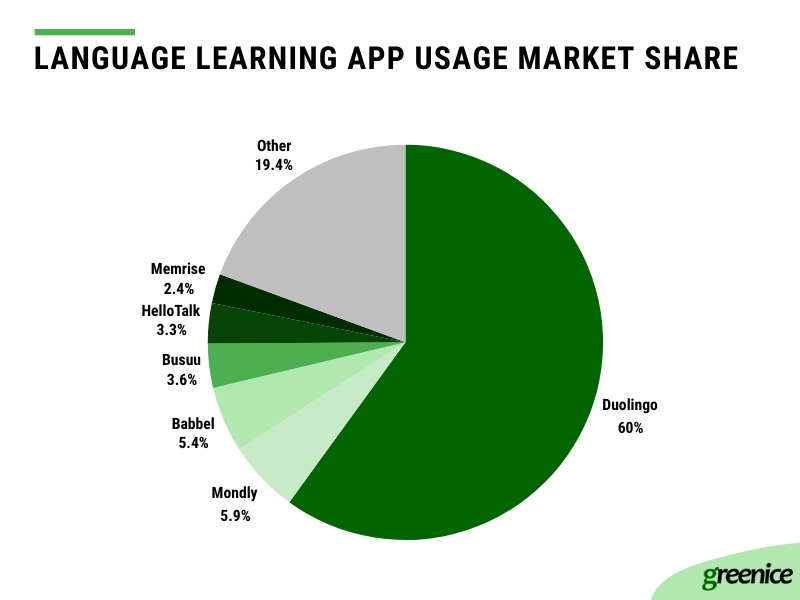
| Name | Overview | Users & revenue | Languages available | Monetization model |
| Duolingo | The most popular language learning app in recent years, Duolingo offers a fun, gamified learning experience | Boasts over 500 million users | Offers courses in 39 languages | Freemium, with ads; offers a premium subscription for an ad-free experience and additional features |
| Babbel | Unlike many of its competitors, Babbel is a subscription-only service, focusing on thorough, conversation-driven content | Reached 10 million subscriptions | Provides courses in 14 languages | Subscription-based only |
| Busuu | Popular in the EMEA region, Busuu offers comprehensive language learning with access to live tutors | Engages over 100 million users worldwide | Offers courses in 12 languages | Freemium; offers a subscription for premium features |
| Memrise | Co-founded by memory experts, Memrise uses mnemonic techniques to aid language retention | Has approximately 35 million users | Provides courses in 16 languages | Freemium, with subscriptions available for access to premium content |
| Drops (by Kahoot!) | Drops focuses on vocabulary acquisition through visual learning | Attracts millions of users, specifics not widely reported | Offers vocabulary learning in 45 languages | Freemium, with a subscription option for additional features |
| HelloTalk | This app facilitates language exchange by connecting users with native speakers | Hosts over 18 million users | Supports language exchange in over 150 languages | Freemium; offers premium subscriptions for extra features |
| Rosetta Stone | One of the oldest and most established language learning companies, offering a wide range of language courses | Specific user numbers not disclosed, but widely recognized as a major player in the language learning market | Offers 25 different language courses | Subscription-based |
| Tandem | Focuses on conversational practice but also includes unique offerings like sign language and constructed languages | Serves millions of users, with specific numbers not publicly disclosed | Supports over 300 languages, including sign languages and constructed languages | Freemium; offers subscriptions for premium features |
| LingoDeer | Specializes in Asian languages, providing structured courses aligned with the grammar and learning styles of each language | Not widely reported, but recognized for high-quality educational content | Offers courses primarily in Japanese, Korean, and Chinese, among others | Subscription-based |
| Mondly | Integrates cutting-edge technologies like VR for immersive language learning experiences | Has over 60 million users | Offers 33 languages | Freemium; also offers VR experiences through paid apps |
You can use one of the platforms as a role model to build a language app.
Do you want to create a website like Duolingo?
Let’s discussLanguage learning apps challenges and how to overcome them with technologies
In traditional education, the teacher coordinates the learning process, encourages students to study, and helps them cope with difficulties.
Online education, on the contrary, relies on a student’s self-discipline and persistence. The aim of technology is to help students organize the self-studying process and stay on track.
There are a number of challenges that online language learning has to overcome. Let’s enumerate the main difficulties language learning apps deal with, and try to find the solutions.
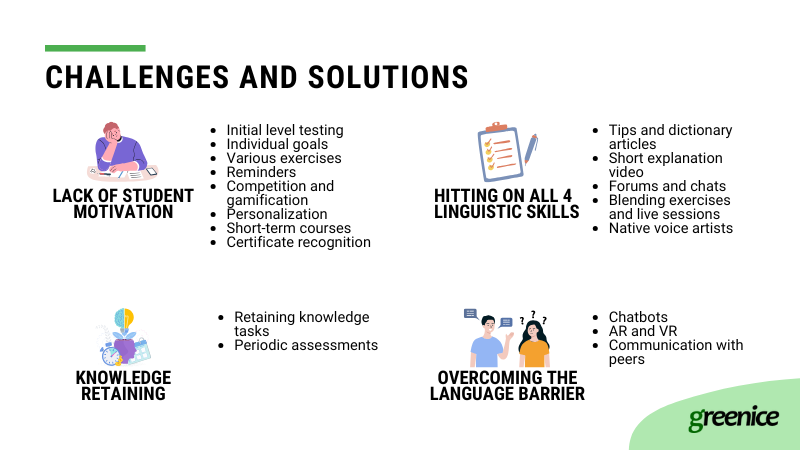
1. Lack of student motivation
"Traditionally, one of the biggest barriers facing language learners is motivation," — said Bernhard Niesner, Busuu's co-founder and CEO.
After several lessons, even highly motivated people start feeling bored and look for an excuse not to attend the next lesson.
Besides boring exercises, people may be unsatisfied with the level of the program (too easy or too complicated), lengthy lessons, lack of grammar explanation, or absence of personalization.
Use some of these ideas to solve the motivation problem:
- Initial level testing
Anyone who has learned the basics of a language may soon get bored doing exercises for beginners and quit immediately. But people who have never studied the chosen language may need more repetition and more time for basic study before they can move on.
So, the first thing after the registration on the platform should be level testing. According to the test results, the users will be assigned to the appropriate level of difficulty.
- Setting individual goals
The next step to maintain high motivation is to set goals. Let the users indicate why they are studying. For example, to get a promotion or move abroad. Seeing their goal each time they open the app will stimulate their thirst for learning.
Bernhard Niesner, Busuu's co-founder and CEO, explains: ‘Retention is closely linked to an individual's goal. For instance, if someone is learning for work, education, or family reasons, they tend to stick with language learning much longer than someone who is learning for travel or fun.’
Also, allow users to set up daily goals quantifiable in a number of earned points for completed tasks. This will help students see daily progress.

- Variety of exercises
In 2012, Duolingo surveyed the students and found that most users dropped out after less than 2 hours of study! The main reason was the monotony of completing the same exercises over and over.
Recently, Duolingo rebuilt their most popular courses from scratch, creating their famous tree of lessons that gradually increases the difficulty of the material. A new sequence of learning processes complies with international standards, the CEFR. With the new system, most Duolingo comments exclaim that lessons are interesting and fun. Most people, who tried to learn a language with the app, were amazed at how addictive the learning process became.

To stimulate the users’ interest, the platform owners need to gradually add new types of exercises. Here is the list of exercises used in Duolingo:
- Arrange all the words into a grammatically correct sentence.
- Complete the translation of a sentence with a missing word.
- Select the correct translation of a sentence.
- Match a picture to a word.
- Fill in the missing word into the blank in a sentence.
- Rearrange the words in the shuffled sentence.
- Speak the word or sentence into the microphone
- Match the word to its translation.
- Type the translation of a sentence.
- Type what you hear in the audio
- Respond to chatbot answers to continue the conversation.
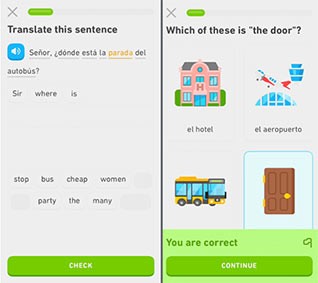
- Reminders to stay on track
Scheduling is very important in our busy lives, so setting reminders to go to a new lesson is a critical feature that will help users continue to study daily.

- Competition and gamification
Even if you do not want to make language learning games, there still should be an element of fun and competition.
For example, in Duolingo users earn 'XPs' (experience points) for each completed task, and after finishing a set of lessons they get a ‘crown’ (or next level opened) and bonus points. The points can be spent on buying ‘lives’ that allow users to continue the lesson if they make mistakes. Also, the number of collected points moves the student's position upper on the leaderboard. And on the contrary, with each missing day of studying, the users lose their positions on the leaderboard. This motivates them to commit to a certain portion of exercise each day. Consistency is one of the most important factors in learning a language. The downside of this experience is that leaderboards have turned people into XP hunters, striving not to learn, but to win the competition.
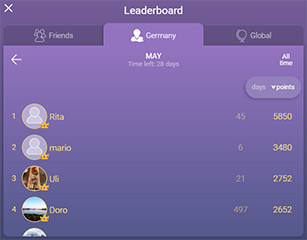
- Personalization
Not everyone learns the same way. People benefit more from a tailored education plan. If there is no personalization, students may feel that they are left with their problems alone.
To improve this, when you create language learning software, add such features as personal vocabulary where users can add new words from exercises, and later, systematically review them.
Let’s look at how Busuu handles personalization. They created machine learning algorithms that track each user’s learning behavior and identifies their personal vocabulary and grammar weaknesses and strengths. This information allows the platform to create personalized vocabulary repetition that helps users memorize difficult words and constructions. Using AI in language learning reduces the learning time because this approach is more immersive and tailored to users’ needs.
- Short-term specialization courses
Language learning ‘marathons’ that last several weeks have become very popular in helping students achieve specific goals. Students can gain specific knowledge like professional slang (business, medical, juridical, maritime, technical, scientific), or they can prepare for an exam or an interview.

- Recognition of app certification by universities and other authorities
Getting a recognizable certificate is a great motivation. If a student is learning a language with the app, it would be nice to have some online testing equivalent to TOEFL or IELTS. Duolingo has already provided such an alternative!
They created the Duolingo English Test (DET). The results of this test are accepted by over 2000 institutions around the world. The users take a test for $49 without preliminary registration and get their results within 48 hours. They would need only a computer and a web camera. The video records and written answers can be sent to any selected university for assessment by the admissions committee. Duolingo owners expected their test to bring them 20% of their revenue by 2021.
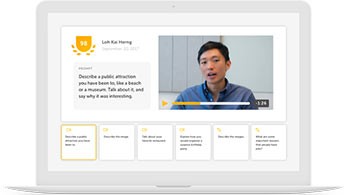
2. Hitting on All four linguistic skills
Language knowledge is judged by progress in the mastering of four skills: Speaking, Listening, Writing, and Reading. So the task of the language learning app owner is to cover all these skills in the app.
First of all, the main problem for online learning is the grammar explanation.
Most of the apps are focused on communication and implicit teaching without long explanations of grammar rules. The user learns intuitively in the game format, making mistakes and remembering different constructions. Then the user can apply the same structures to other sentences. However, each language has many exceptions and its own peculiarities that need clarification. Without understanding the grammar rules, the user will always make the same mistakes.
According to the 2019 survey of Busuu users, 20% of learners would like more grammar instruction from the platform.
Intuitive learning is good at the beginning stages when grammar is simple and education is focused on memorizing vocabulary. But when the topics become more complicated, users need more explanation. Here are some ideas for solving this challenge:
- Integrate tips and dictionary articles that can be opened by tapping or hovering over the word and can show the remarks of usage and possible word forms. For instance, Busuu developed a feature called Grammar Review. Due to machine learning technology, the app can predict exactly what the student needs and helps them practice their weaknesses.
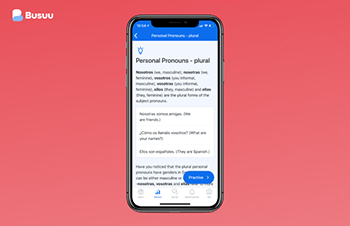
- Show a short explanation video before each new lesson and then practice the rule with the exercises.
- Some platforms also use forums and chats where users can ask for clarification from natives and peers.
- Finally, you can blend exercises and live sessions with a real teacher who can coordinate the learning process and program according to the student’s needs.
Another problem is pronunciation. The apps usually pronounce words with a computer voice without intonations and without explanations of how to articulate the sounds correctly. Thus, users struggle with listening and speaking.
To overcome problems with pronunciation, you should hire native voice artists who can record exercises and dialogues.
Memrise uses short videos where locals use definite phrases to help students develop listening and comprehension of accents.
Technically, the app needs an excellent speech recognition system, to understand the users’ speech and evaluate the correctness of users’ pronunciation.
3. Knowledge retaining
An average Duolingo course introduces its learners to about 2,000 words. The app states that 34 hours at Duolingo equals one semester of learning a language at the university. But all newly acquired information is easily forgotten if not repeated.
Here are some ideas on how to help students retain what they have learned:
- Retaining knowledge tasks
From time to time, students need to repeat the material or they will quickly forget it. Spaced repetition exercises can help with that. For example, Duolingo has five difficulty levels on each topic. When the user completes all five, the topic is considered finished and is highlighted with gold color. However, after some time, the level’s icon gets shattered, signaling that the content needs to be reviewed.
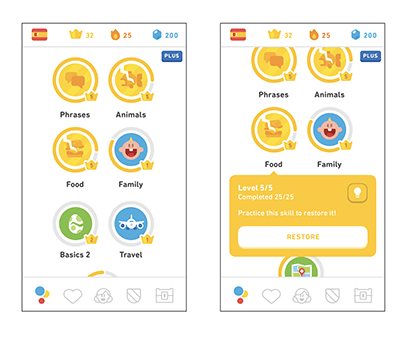
- Periodic assessments
The best way to know your progress is by passing a test. The app should provide controlled checking in the middle of the process and at the end of each section. This will convince the students that they are doing well or it will show them that they are not serious enough and need to repeat the material.
4. Overcoming the language barrier
With traditional teaching, many students are afraid to make mistakes and get bad marks. This continues after the course when people meet natives and they are afraid to test their skills.
- Chatbot communication to overcome the language barrier
Chatbots can simulate conversational dialogues and bring about fearless speaking.
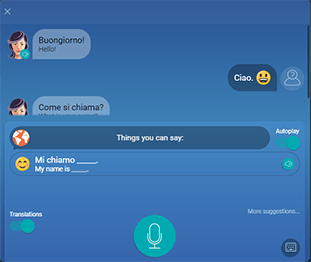
Several years ago Duolingo had a chatbot that was very popular but the company removed this feature. Today, the feature is active again and powered by the GPT-4 model from OpenAI.
The main challenge for companies, right now, is to create a chatbot that will be able to support live conversation, not only the ‘canned’ answers. And it looks like we are now standing on the threshold of such innovation.
Japanese startup TerraTalk is experimenting with an AI-powered app that allows Japanese students who are learning English to speak to a conversational assistant that will reproduce a live situation. The app is able to understand what the student says and give feedback. Such talking with a chatbot allows the student to overcome shyness in speaking to natives and the fear of making a mistake.

Another project is the newest app LanguageChat. It combines AI and Cloud Natural Language API from Google, AWS, and Azure to allow users to generate their own content creating the topics that are interesting to them. The project was presented on Kickstarter and has already attracted its first subscribers.
- Getting more immersive learning with AR and VR
Augmented and virtual reality has started to penetrate language learning platforms. You can check how Mondly uses VR technologies for better language immersion. The students virtually get into common-place situations in airports, hotels, or zoos to interactively learn new expressions and to train their listening and speaking with the bot. This is not only effective but also fun!
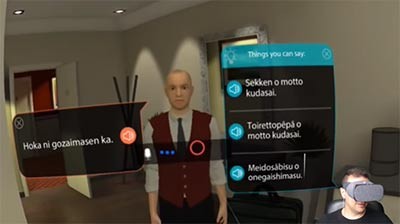
As you see, more and more companies are integrating Artificial Intelligence to offer advanced services to their customers. If you want to learn more read our article on how to build an AI software and learn how to create an innovative product.
- Communication with peers
Forums and chats with peers can help students gain confidence in their skills as they start communicating with foreigners. This practice shows the level of language proficiency perfectly and breaks down the barriers to communication.
How to make a language learning website
Now let’s move to the technical part, and examine how to make an app like Duolingo or Babbel. How to structure the development process to achieve the best result? Let us give you a plan.
Here are the steps in the language learning app development process. Most of these steps go in parallel to speed up the process.
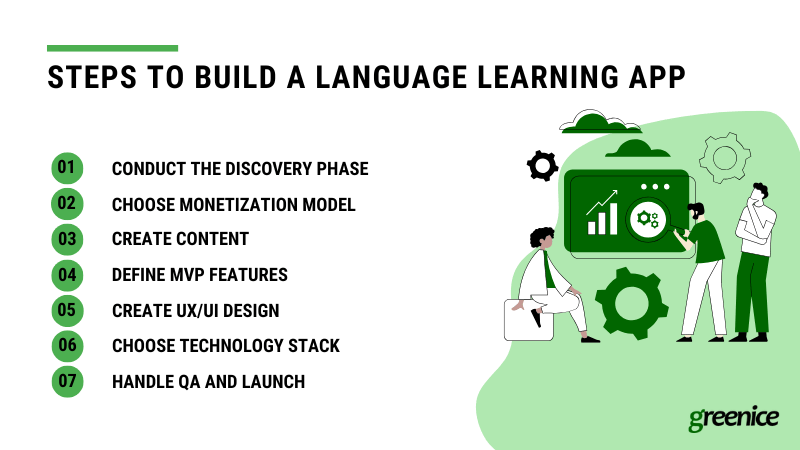
1. Conduct the Discovery phase
The initial step in creating a language learning app is conducting the discovery phase. This crucial stage involves three key components: clarifying your app's concept and value proposition, conducting a thorough business analysis, and developing a Software Requirements Specification (SRS).
The concept and value proposition help define what makes your app unique and valuable to potential users, ensuring it stands out in a crowded market. Business analysis provides a solid foundation for your app by analyzing market demands, potential user bases, and competitors, which guides the strategic planning of your product. Lastly, the SRS outlines detailed app requirements and functionalities, ensuring that every feature supports your business goals while meeting user needs.
At Greenice, we excel in the discovery phase, combining expertise with a deep understanding of technology trends to lay a robust groundwork for your project. Our experienced team ensures that your language learning app not only meets market needs but also offers a compelling learning experience, positioning you for success in the competitive edtech space.
2. Decide how you are going to make money
The platforms use one or a combination of the following business models:
- Freemium model: the app and the website are accessible without charge, although some extra features are offered with a paid subscription.
- In-app ads: users pass courses for free, but if they want to remove the ads, they have to pay a fee.
- Subscription: monthly or yearly payments.
- One-time purchase of a complete course.
Surprisingly, many platforms offer most of their features for free. Nonetheless, in 2022, Duolingo's yearly earnings amounted to $0.369B which was an increase of 47.34% compared to the previous year. Part comes from only less than 2% of paid Duo’s subscription users. Other revenues come from ads, investors, and paid English Tests (analog of TOEFL).
3. Create content
Content is the main thing — exercises, grammar tips, illustrations, and sounds.
You will need to create really amazing content: it should be relevant, up-to-date, appealing, and even amusing. Hire language teachers, volunteers, students, actors, and graphic designers to make the material.
Babbel learning content is created by a professional team of over 150 linguists and language teachers. But in the beginning, you do not need to hire such a big team.
Here is how Duolingo started working on its content.
At the dawn of the creation of their first courses, Severin Hacker and Luis von Ahn, the founders of Duolingo, read a ton of books on language teaching and built basic courses for English speakers who were learning Spanish and German. For that, they googled the 3,000 most commonly used words in each language and translated them into English to create simple exercises. Based on this, they created an algorithm for lessons. Two years after they launched the website, they attracted professional linguists and second-language-acquisition researchers to create grammar tips and conjugation tables. As good revenues were coming in, Duo’s owners started adding new languages and recruiting native-speaking enthusiasts willing to help create a vocabulary for new courses.
4. Define features for the MVP
The next critical step is to define the features for your Minimum Viable Product (MVP). An MVP approach allows you to launch a product with enough features to attract early adopters while minimizing development costs and time. For a language learning app, essential features might include user registration, basic language lessons, progress tracking, and an interactive user interface. Additionally, incorporating gamification is crucial as it significantly enhances user engagement and retention.
Integrating game-like elements such as points, badges, and leaderboards can transform the learning process from a routine task into an exciting and addictive journey. For instance, learners could earn points for completing daily lessons or challenges, and badges for milestones like finishing a language module. This not only motivates learners to stick with their lessons but also fosters a sense of accomplishment.
Incorporating such features thoughtfully can make the learning experience more interactive and enjoyable, encouraging consistent usage and improving retention rates. By designing an app where users feel continuously rewarded for their efforts, you create an environment conducive to sustained learning and regular engagement.
5. Create a UX/UI design
Creating an effective UX/UI design is crucial in developing your language learning app. This step involves understanding the core purpose of your platform and optimizing the user workflow to align with learning goals. A visually appealing and intuitive design is especially important in language learning apps, where exercises often utilize interactive elements like flashcards and image associations.
For example, successful language apps like Duolingo and Babbel employ vibrant visuals and interactive elements that engage users—flashcards in these apps are designed to be memorable and intuitive, aiding in vocabulary retention through visual cues.
When designing your app, focus on a clean, straightforward interface that facilitates easy navigation and minimizes distractions, enhancing the learner's focus and interaction. Well-designed UI elements should make learning not only effective but also engaging, increasing the likelihood of user retention and app success.
6. Choose technology stack
Choosing the right technology stack is essential for developing a language learning app that is both efficient and scalable. A cross-platform approach is recommended to cater to the majority of mobile users, as typically, 80% of app traffic comes from mobile devices. Cross-platform development allows your app to operate seamlessly on both iOS and Android, ensuring a wider reach.
Front-end technologies: For the front-end, technologies like React Native or Flutter are popular choices. React Native allows for native-like app experiences using JavaScript, while Flutter, based on Dart, excels in building beautiful, natively compiled applications quickly. Both technologies enable the development of interactive elements such as buttons and text input fields, which are essential for engaging user interfaces in language learning apps.
Back-end technologies: On the back-end, PHP with the Laravel framework, combined with a MySQL database and AWS for cloud services, forms a robust stack. This setup ensures that user requests are processed efficiently, handling everything from user authentication to data storage and retrieval.
AI technologies: To further enhance the learning experience, integrating AI technologies can be a game-changer. Using platforms like OpenAI, Anthropic, or Gemini can add sophisticated features such as natural language processing, voice recognition, and personalized learning paths. These AI enhancements can make the app not only more interactive but also more adaptive to individual learning styles.
By integrating these technologies, your app can offer a comprehensive, engaging, and effective language learning experience. Choosing the appropriate stack and incorporating AI can differentiate your app from competitors, making it more appealing to users and potentially more successful in the market.
7. QA and launch
The final steps before releasing your language learning app into the wild are Quality Assurance (QA) and Launch. These are critical phases that ensure the app not only functions as intended but also provides a seamless and enjoyable user experience.
Quality assurance: QA involves thorough testing of every aspect of the app to identify and fix any bugs or issues. This includes functional testing to ensure that all features work correctly, usability testing to guarantee the app is intuitive and easy to navigate, performance testing to ensure the app operates smoothly under various conditions, and security testing to protect user data. For a language learning app, it's also vital to conduct content accuracy tests to verify that the educational material is correct and effective. Automated and manual testing methods are often used to cover all possible use cases and user interactions.
Launch: Once QA is satisfactorily completed, the next step is launching the app. This involves several key activities:
- Pre-launch marketing: Build anticipation and interest through targeted marketing campaigns. This could include social media announcements, email newsletters, and promotions to generate buzz around the app.
- App store optimization (ASO): Optimize the app’s listing with compelling descriptions, keywords, and visuals to improve visibility and attract downloads from the App Store and Google Play.
- Release: Deploy the app on the selected platforms. It’s often wise to roll out the app gradually, starting with a soft launch in a limited region to gather initial user feedback and make any necessary adjustments.
- Post-launch monitoring: After the launch, closely monitor the app for any technical issues that might have slipped through the QA process. Pay attention to user feedback and app performance metrics to identify areas for improvement. Regular updates should be planned to address these insights, add new features, and continuously enhance the learning experience.
By diligently conducting QA and executing a strategic launch, you can ensure that your language learning app delivers on its promises, providing users with a reliable, engaging, and educational tool that meets their language learning needs.
How much it costs to build a language learning app
The cost of developing a language learning app can vary significantly based on the chosen development approach.
White-label solutions serve as a practical middle ground, utilizing pre-built scripts that allow for quicker launches and cost efficiency, with prices ranging from $5,000 to $15,000 depending on the extent of customization and added features.
For maximum flexibility and control, custom solutions are ideal, permitting the integration of unique features and complex functionalities. Starting from $10,000 for a minimum viable product (MVP) at Greenice, this approach's cost can escalate significantly depending on the complexity of the features and the development team's hourly rate, which is influenced by their geographic location and level of expertise.
Entrepreneurs must carefully balance cost, quality, and functionality when selecting a development strategy to ensure it aligns with both their budget and business objectives.
How to apply this to your business
In this article, we've explored several key considerations essential for creating a language app:
- Understanding the market: The language learning app market is growing rapidly, driven by high demand, technological advancements, and seasonal trends. Recognizing key players and their strategies is essential for entering this competitive field.
- Overcoming challenges: Addressing common issues like user motivation, retention, and effective skill-building is critical. Solutions include gamification, personalized content, AI-driven tools, and immersive technologies like AR/VR.
- Steps to build an app: Developing a language learning app involves defining the value proposition, selecting essential features, creating engaging UX/UI designs, choosing a scalable tech stack, and ensuring quality through QA before launch.
- Leveraging technology: Incorporating AI tools like OpenAI for personalized learning and speech recognition enhances user engagement and keeps apps competitive in the market.
- Cost of development: Options range from white-label solutions to fully custom apps, depending on features and complexity. Balancing cost with functionality is crucial for success.
From our side, we can provide full technical consultation, help with the identification of requirements, and development of your project from scratch. We have expertise in creating eLearning platforms and educational games for universities, conferences, and businesses. Don’t hesitate to write to us and ask your question. We are looking forward to starting a new amazing online learning website!
Need to estimate your language learning app features?
Get a Free Quote Now!Rate this article!
5







 Sign in with Google
Sign in with Google
Comments (0)